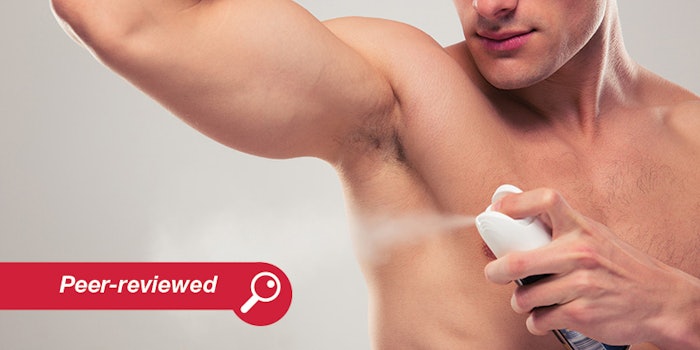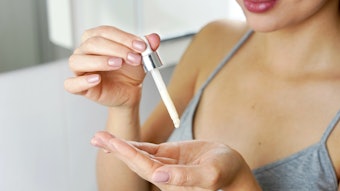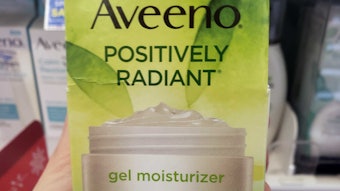
To read this article in its entirety, click through to your January 2020 digital magazine; also see the related "Letter to the Editor" regarding this piece.
Sweat components consist mainly of an aqueous solution of ions: sodium, potassium, calcium chloride, lactate, bicarbonate and organic molecules like urea, amino acids, oligo saccharides and peptides. At the moment of its release from sweat glands, sweat is an odorless liquid, but metabolism by cutaneous bacteria quickly transforms some of its components, e.g., leucine, into a series of volatile substances, e.g., isovaleric acid, that are responsible for malodor.1 As such, excessive axillary sweating and unpleasant underarm odor production represent a serious discomfort in hot climates.
Most existing tools for perspiration control are personal care products containing aluminum-based salts such as chloride or chlorohydrate, and aluminum/zirconium chlorohydrate complexes with glycine, propylene glycol or polyethylene glycol. These are traditionally used to reduce sweating and odor formation as well as to provide some deodorant activity due to their antimicrobial efficacy—with the help of long-lasting perfumes.
Recently, concerns over the environmental impact of aluminum salts2 as well as health3 and skin irritation concerns have been expressed. The latter is due to the release of hydrochloric acid from chlorine-based aluminum compounds, and the deep alteration of the axillary microbiome induced by their continuous use. As such, the industry has moved to eliminate soluble aluminum from antiperspirants.4, 5
Effective as antiperspirants, aluminum salts, when dissolved by sweat, act by diffusing into the ducts of eccrine sweat glands, where the trivalent aluminum ions react with hydroxide ions and entities such as proteins and produce insoluble and bulky aluminum hydroxide species. These species are responsible for the in situ plug formation that serves to block ducts.
Traditional aluminum chloride-based salts induce the formation of deep plugs in the eccrine sweat glands, which provides lasting effects until the gland’s functionality recovers. However, during this process, a significant amount of hydrochloric acid (HCl) is progressively released, which can cause skin irritation accompanied by stinging, burning and erythema. Partially neutralized aluminum salts as aluminum/zirconium chlorohydrate glycine complexes produce a lower amount of HCl and cause a more superficial blockage than AlCl3 or ACH, accompanied by reduced skin irritation phenomena.6, 7 However, even less irritating, a biomimetic hydroxyapatite was found to effectively absorb sweat rather than block its production and without releasing HCl, as it contains no chlorine.
Biomimetic Hydroxyapatite
The term biomimetic, as used here, refers to synthetic materials, substances, devices or systems that imitate nature. Indeed, our bones and teeth are mainly made of mineral structures belonging to the group of hydroxyapatites (HA)—complex hydroxyl-phosphates with calcium ions as their principal cation. Biological HA is a phosphate-based mineral, non-stoichiometric according to the ideal formula of hydroxyapatites: Ca10(PO4)6(OH)2, with a typical Ca/P molar ratio of 1.67.
Within the specific parameters of the hydroxyapatite mineral lattice, Ca2+ can be substituted by other ions such as Zn2+, Mg2+, Na+ and K+, while the phosphate and hydroxyl anions can be replaced by fluoride, chloride or carbonate. This happens with some deformation of the crystalline lattice, as hydroxyapatite works as a sort of mineral “sponge,” capable of adsorbing ionic or polar species in general according to the composition of its environment.
Calcium-deficient (non-stoichiometric) HA has both cation (Ca2+) and anion (OH–) vacancies, and a Ca/P ratio of between 1.67 and 1.5. Interestingly, carbonated calcium-deficient HA is the main mineral constituent of mature dental enamel (95% w/w) and dentine (75% w/w), and up to 70% w/w of human bones is composed by “bone apatite”; i.e., multi ions-substituted carbonated HA. Such biogenic HA exhibits a crystal lattice composition with a low degree of crystallinity, rough surface, high hydration state and high degradability. Ions-substitution can influence its stability, crystallinity degree, crystal size and morphology, thus affecting the absorption of the biological medium.8, 9 In other words, biogenic hydroxyapatite has the special property of easily adsorbing external molecules in its structure.
HA has been reported to act as an adsorbent for toxic inorganic ions from aqueous media through an exchange reaction with Ca2+ or PO43- in the HA structure. Moreover, when prepared under a biomimetic condition, it is capable of capturing malodorous organic and inorganic compounds. In particular, the replacement of calcium in HA by divalent cations such as Zn2+ increases its malodorous gas-adsorbing features.
In detail, zinc ion, inserted in the HA complex, works as a middle force Lewis acid, which is able to interact with malodorous substances such as NH3 (hard Lewis base) and H2S (soft Lewis base), contributing to a significant adsorption of both through its electrophilic nature. Along with these adsorbing features, substituted HA shows decreased particle size, together with a high specific surface area and high content of adsorbed water. The low crystallinity index and the rough surface improve HA biocompatibility, while the abundant hydration layer is responsible for good adsorption properties and ion activity.10 For these reasons, biomimetic apatites are already being used as in vivo delivery systems for drugs, proteins and genes.
Hypothesis: Biomimetic Apatite for Sweat Control
Considering the described properties of HA and the biochemistry of sweat, the development of a new perspiration trigger and deodorizing system based on modified hydroxyapatite (HA) structures was hypothesized. This led to the study of a specific biomimetic active form of this material, described here.
An active based on biomimetic calcium HA, functionalized with a specific series of different ions, i.e., zinc and magnesium, was developeda as a white suspension, with a pH between 6 and 8. The calcium/zinc/magnesium HA blend also contains zinc PCA, which works in synergy to develop astringent, deodorizing and bacteriostatic activities. Its efficacy in sweat control was assessed through in vivo gravimetric hot room testing, described in the next section.
Calcium phosphates such as biomimetic HA demonstrate pH-dependent activity; i.e., they are increasingly active as the pH decreases below 6.0—a property offering great advantages for delivery/release.
Continue reading in your January 2020 digital magazine...











